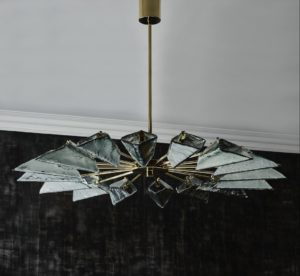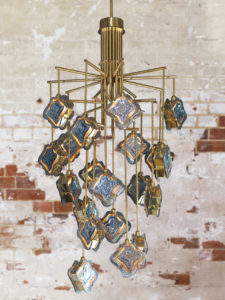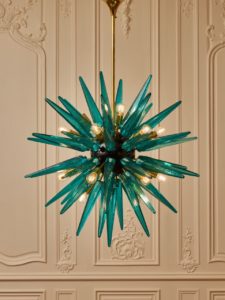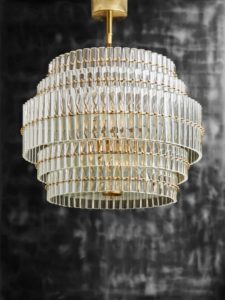404. Page Not Found.
Throughout the 20th century, chandelier designs underwent a fascinating evolution, reflecting the influences of various artistic movements and technological advancements. From the opulent and ornate chandeliers of the early century to the sleek, minimalist designs of the later years, each era brought its own unique style and interpretation.
Art Nouveau (Late 19th to Early 20th Century):
The Art Nouveau movement, with its focus on organic forms and curvilinear shapes, laid the
foundation for innovative chandelier designs. These chandeliers often incorporated intricate metalwork and stained glass elements. A beautiful example is this French 1930s chandelier from our collection, showcasing the influence of Art Nouveau with its graceful, flowing lines and floral motifs.
Art Deco (1920s-1930s):
The subsequent Art Deco movement embraced geometric patterns, sleek lines, and luxurious materials. Chandeliers from this era often featured multiple tiers of glass or crystal prisms, mirroring the symmetrical compositions prevalent in Art Deco architecture. A striking and artistic embodiment of this style is the “helicopter” from Murano, Italy, exhibiting clean lines and a symmetrical arrangement, epitomising the attention paid to balance and form at this time.
Mid-Century Modern (1940s-1960s):
The mid-20th century brought a shift towards minimalism and functionalism, which greatly influenced chandelier design. Mid-century modern chandeliers often emphasized simplicity, featuring clean, straight lines and geometric shapes. The Mid-Century modern style is broad in its range of expression and we have stocked many pieces from the era, though some examples of pieces of the style are our Stilnovo fixtures.
 Hollywood Regency (1950s-1960s):
Hollywood Regency (1950s-1960s):
During this era, glamorous chandeliers became synonymous with Hollywood’s golden age. Highlighting opulence and luxury, chandeliers in the Hollywood Regency style featured flowing crystals, gold accents, and dramatic lighting effects. This era is defined by the clashing elements of overdone and frivolous vs sleek and defined and a number of chandelier designs could fit this aesthetic, including many that are already on this list.
Space Age and Pop Art (1960s-1970s):
The 1960s and 1970s saw a blend of futuristic aesthetics and bold colors, echoing the influence of space exploration and the emergence of pop culture. Chandelier designs during this period often featured unusual materials, such as plastic and metal, and incorporated bright or neon colors. The “Sputnik” Chandelier captures the essence of this era with its vibrant design, resembling the Soviet satellite sputnik that was launched in 1957.
 Postmodernism (1980s onwards):
Postmodernism (1980s onwards):
Postmodernism in chandelier design embraced eclecticism, irony, and a rejection of minimalist principles. These chandeliers often presented a mix of materials, styles, and colors, challenging traditional design expectations. One intriguing example is this piece from Renaissance London (link to store page), cylindrical glass pieces with industrial metal elements, creating a captivating fusion of juxtaposing shapes and materials.
Over the course of the 20th century, chandelier designs evolved and reflected the rich tapestry of artistic, cultural, and technological movements that shaped each era. From the organic curves of Art Nouveau to the sleek minimalism of mid-century modern, and the bold experimentation of postmodernism, every decade left its mark on chandelier design.
Through distinct examples of chandeliers, we have journeyed through these transformative periods and witnessed the eternal dance between form and function, tradition and innovation. While inspired by historical contexts, chandeliers have also served as artistic expressions, reflecting our desire for beauty, status, and the playful exploration of new frontiers.
In the face of changing times, the chandelier has transcended its mere functional purpose, becoming an icon of design, a sparkling centerpiece that illuminates not only spaces but also the imaginations of all who make memories underneath them.
